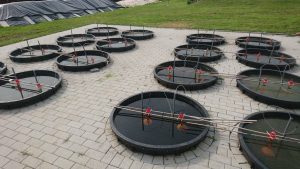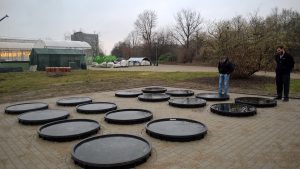Comeniuslaan 4, 6525 HP Nijmegen
Sarian Kosten
Please login or request access to view contact information.
16 (appr. 800L) outdoor mesocosms 115 × 75 [diameter × depth in cm]; roughly 1 m²) placed into the ground to buffer temperature fluctuations. Electricity and potable and groundwater taps nearby.
The 2-year old mesocosms have been used to study the effect of fish on sediment-water nutrient fluxes and greenhouse gas emissions. Earlier mescosms work (in the previous set of mesocosms) focused on the impact of eutrophication on different plant species.
None (exposed to ambient light, temperature fluctuations dampened because the mesocosms are dug into the ground.
Greenhouse gases, biogeochemistry (emphasis on eukaryotes (fish & plants) on GHG emission, conservation (e.g. effect of prevention of bioturbation on submerged macrophytes)
Eutrophication, primary producers, fish, biogeochemistry, greenhouse gases
The carbon balance of inland waters
Effects of climate change on aquatic ecology and water quality
Competition between different groups of primary producers (submerged and floating macrophytes, algae and cyanobacteria).
The Institute for Water and Wetland Research of the Radboud University and the Department of Aquatic Ecology and Environmental Biology maintain a state-of-the-art biogeochemistry lab with expert technicians and analytical equipment for, among others, next-generation (NIRS-CRD) gas analyzers (Picarro G2508 & Los Gatos Ultraportable GGA), an IRGA for dissolved CO2 and CH4 measurements, instruments for the chemical analysis of water and sediment (ICP-OES, ICP-MS, spectrophotometric analyzers, microwave destruction units, DOC/DON analyzers, C-N analyzers, HPLC, HPLC-amino acid analyzer, IRMS, Phytopam). In addition, we have microscale dissolved oxygen micro-optodes and micromanipulator as well as O2 spots for non-invasive measurements in bottles and cores (all Presens), freeze-dryers and analytical balances including a sedimentation balance. Our field instrumentation includes HOBO light and temperature loggers, Hach multimeters for conductivity, temperature, pressure, and optical probes for dissolved oxygen. Furthermore, the department is well equipped with experimental facilities with, besides our mesocosms, greenhouse facilities, aquaria and pumping systems, water-baths, climate rooms. A GC-MS for CH4 stable isotope analysis is available at the Microbiology Department.
Guest house at a distance of <500m.
https://www.ru.nl/english/about-us/services-facilities/guesthouse/
https://www.ru.nl/bgard/research-facilities/experimental-field/
https://www.ru.nl/science/aquatic
Oliveira Junior, E. S., R. J. M. Temmink, B. F. Buhler, R. M. Souza, N. Resende, T. Spanings, C. C. Muniz, L. P. M. Lamers and S. Kosten (2019). “Benthivorous fish bioturbation reduces methane emissions, but increases total greenhouse gas emissions.” 64(1): 197-207.
Tang, Y., S. F. Harpenslager, M. M. L. van Kempen, E. J. H. Verbaarschot, L. M. J. M. Loeffen, J. G. M. Roelofs, A. J. P. Smolders and L. P. M. Lamers (2016). “Aquatic macrophytes can be used for wastewater polishing, but not for purification in constructed wetlands.” Biogeosciences Discuss. 2016: 1-32.
 |
 |
